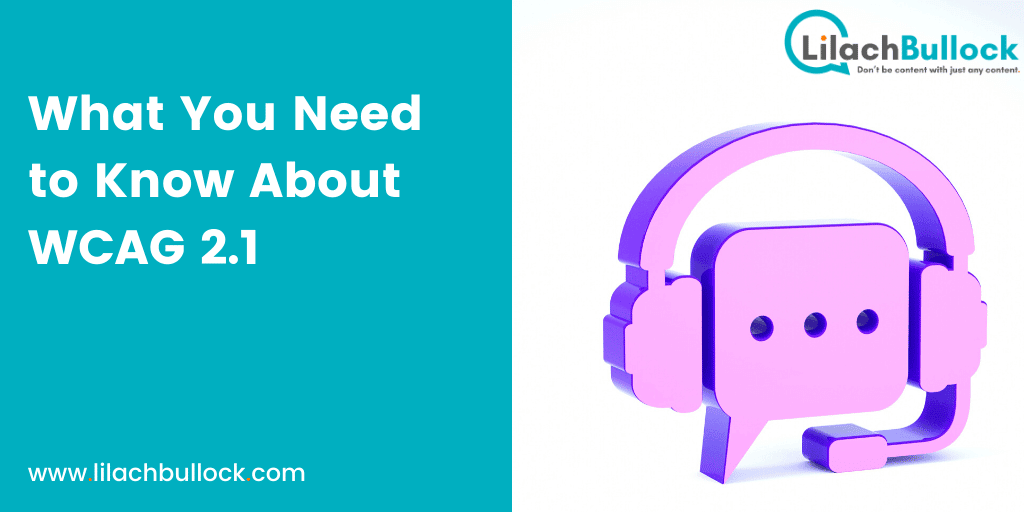Follow Lilach

What You Need to Know About WCAG 2.1

WCAG 2.1 is W3C’s latest update to their content accessibility standards. WCAG (which stands for Web Content Accessibility Guidelines) was created by the World Wide Web Consortium (W3C) in order to both increase and enhance disabled people’s access to the web.
The WCAG 2.1 guidelines aren’t an entirely new set of standards, rather they’re simply an expansion on top of WCAG 2.0. The levels of compliance (and systems of organization) have not been changed, but instead, they’ve been built on. If you’re still unclear on what WCAG is, and how it affects the internet, we’ve got you covered. Below we go into detail on exactly what WCAG is, who it applies to, and why it’s a big deal for the internet..
WCAG: What It Means & Why It’s Important
Most people who run a business on the internet, or who otherwise conduct business on the web, have heard of WCAG. They know that it’s related to the ADA (Americans with Disabilities Act), and that it’s enforced by the federal government.
However, most people fail to realize that WCAG is accepted across the world as the gold standard of web accessibility. This means that web accessibility isn’t something that’s just important in the US. Rather, web accessibility has become an important aspect of web development in North America, Europe, and Asia too.
Is Being Compliant With WCAG Legally Required?
The answer to this question really depends on what type of business you operate online. If you have any ties to the federal government (or you are in fact a federal agency/organization), then you need to be compliant with WCAG. Section 508 of the ADA makes numerous references to WCAG.
This means that if you do business with the federal government (as a contractor, vendor, subcontractor, etc.), then you probably need to make sure that your web content (and ICT in general) is compliant with WCAG.
WCAG 2.0 & WCAG 2.1
As we’ve already mentioned, WCAG 2.1 isn’t a brand new set of guidelines, it’ s just an update of 2.0’s guidelines. WCAG 2.1 doesn’t change anything in WCAG 2.0, it simply builds on top of its already established guidelines.
With that being said, there are over 10 additional features to WCAG 2.1 that are relatively new additions to the guidelines. Most of these additions focus on enhancing the UX (user experience) of disabled internet users, as well as mobile accessibility issues.
WCAG 2.1 Updates
Below are some of the new additions/focuses of WCAG 2.1, including a brief overview of each.
1. Device Orientation
The physical orientation must be fully supported for both horizontal and vertical displays. This means that content must be able to be viewed on both types of displays. This obviously applies mostly to cell phones and tablets.
2. Inputs Must Have Clearly Defined Purposes
Many disabled users utilize screen reading technology and similar applications in order to browse the internet. If an input field doesn’t have a clearly defined purpose, that can cause problems for these users.
3. Responsiveness is Key
Making sure that all of your content is responsive across multiple device types is incredibly important (both from a UI and UX standpoint).
4. Contrast of Colors
One of the new focuses of WCAG 2.1 is an emphasis on the contrast of both non-textual and textual content. If users who suffer from vision problems are browsing your content, they need to be able to clearly see and identify the content on your site/application.
5. Textual Content Needs to Have Custom Options
This applies mainly to text content, and specifically in regards to the resizing/spacing of that content. Users need to be able to resize and/or respace textual content.
6. Motion-Activated Features
WCAG 2.1 also includes a focus on making sure that motion-activated content (such as requiring a user to shake their mobile device to perform a site function), must be able to be performed without doing the actual motion (or otherwise completely turned off). This is important for those users who are physically unable to perform those types of movements.
7. Easy Transitions Between Devices
Input devices such as a user’s mouse, keyboard, microphone, etc. should all be able to be interchanged with one another. This is important for people who need to use different forms of input devices/control. An example of this would be someone using a mouse or keyboard with their mobile device (through a special app or input control).

Follow Lilach















